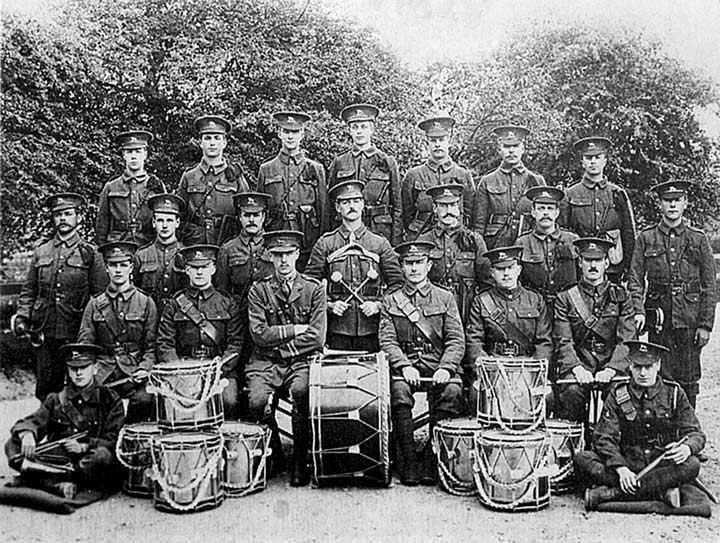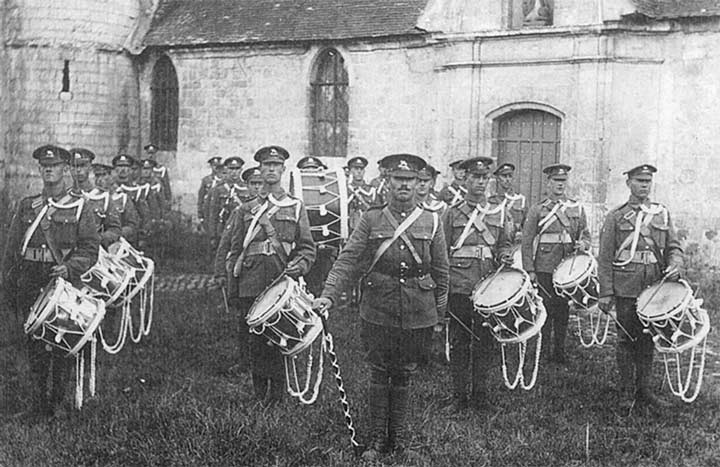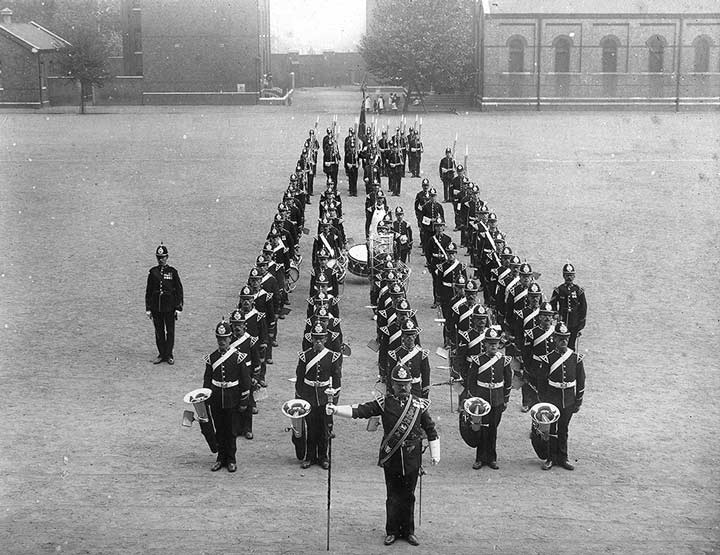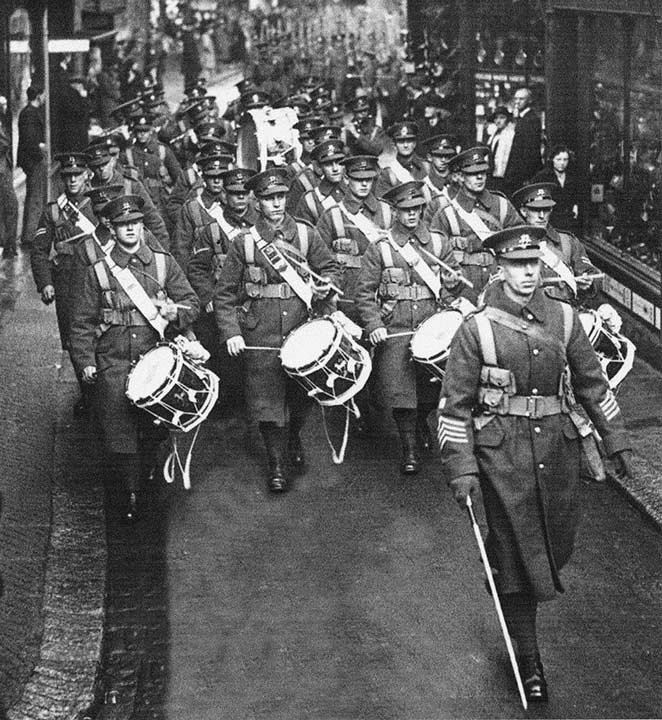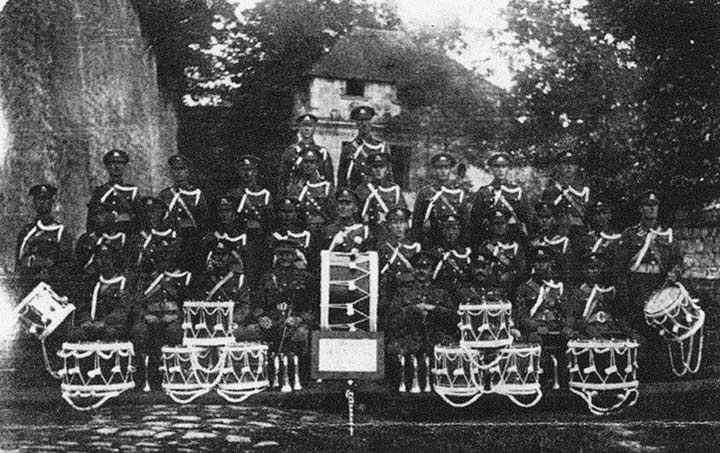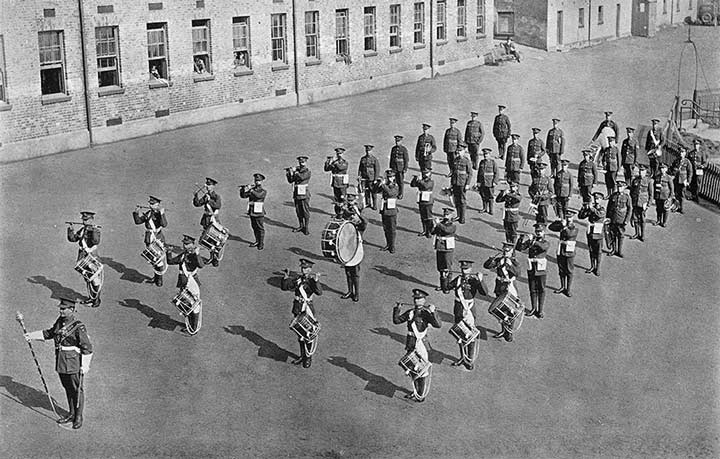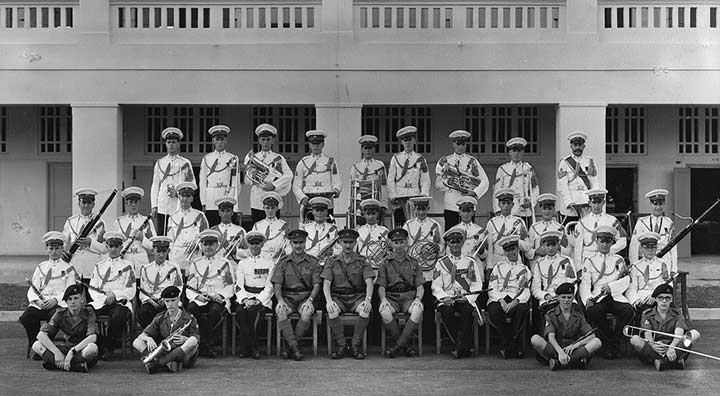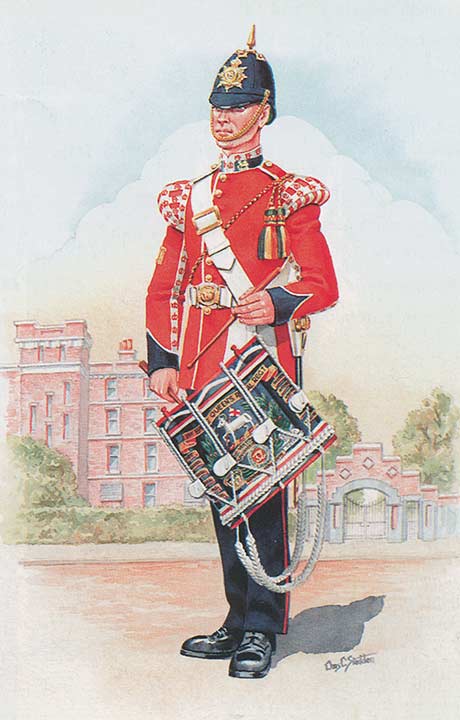 Band and Drums Music
Band and Drums Music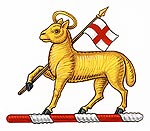
The Queen's Royal Regiment (West Surrey)
Quick Marches
The Old Queen's, the Regimental Quick March of the 2nd Queen's Royals prior to 1881. After it had been in use by the regiment for many years, the march was banned by Queen Victoria who objected to the fact that it contained an adaptation of 'God Save the Queen' (see details under 'Braganza'), in spite of this ban, 'The Old Queen's remains incorporated in the music of the regiment, being played on Officers Mess Dinner Nights only.
'The Old Queen's'
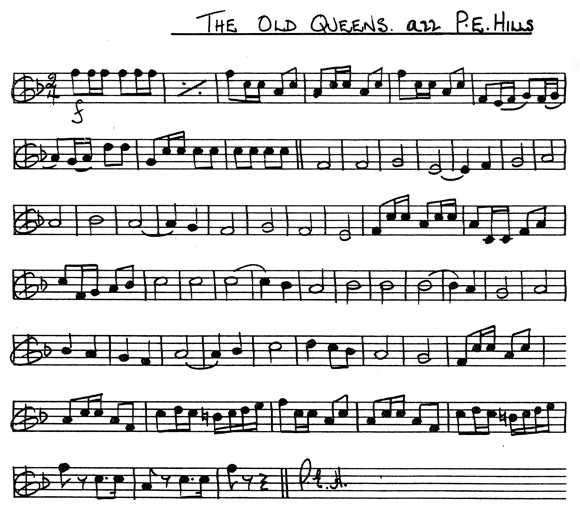
After the loss of The Old Queen's, the Regiment had no official March Past until 1903 when Braganza was formally approved. The 1st Battalion in particular were upset at the loss of The Old Queen's and for a number of years they refused to play anything else on various march pasts and became known as 'the Silent Second'.
The late Brigadier General F J Pink CB CMG DSO writing to the Colonel of the Regiment in 1924 stated that he and his brother officers in the 1st Battalion, had always been informed that Queen Victoria's uncle, The Duke of Kent had introduced the The Old Queen's when he commanded the Regiment in Gibraltar. Nevertheless no written authority could be found.
The Old Queen's (Marsch über Nationalmelodien) Further research by Major Richard Powell and Colonel David Murrey believe that the Old Queen's march is in fact, Marsch über Nationalmelodien, (Later. PreuBenmarsch) by Joseph Golde, it became a Prussian Army March in 1840. The Royal Director of Music Joseph Golde, (1827-1862). The first part of the march is, Heil Dir im Siegeskranz, while the trio is a patriotic song.
Ich bin ein PreuBe, (I am a Prussian). A similar march by Piefke, the "Siegesmarsch", uses the Spontini royal anthem as its trio.
On the birthday of Friedrich Wilhelm III on 03 Aug, 1883, "Heil Dir im Siegeskranz" was decreed to become the "Prussian people's anthem" and as such it remained untouched until 1918. There was only one slight change in 1871, when the line (in the lyrics) "Heil König Dir!" was replaced by "Heil Kaiser Dir!"
The second song, Ich bin ein PreuBe, kennt ihr meine Farben? (I am a Prussian, do you know my colours? [i.e. the colours of the Prussian flag]) has two authors: the music was composed by August-Heinrich Neithardt (1793-1861), bandmaster of the Grenadier Guards Regiment No. 2, while the words go back to a teacher at a secondary school in Halberstadt, Dr. Bernhard Thriersch (1794-1855).
In 1922 the march was changed to now incorporate a new national anthem which remains in effect today. While the trio was unchanged, Heil Dir im Siegerkranz was replaced by the Deutchlandlied. (W Probst)
'Braganza'

Braganza The Regimental Quick March of The Queen's Royal Regiment. Soon after the formation of the Regiment in 1661, it was dispatched by Charles II to garrison Tangier, which formed part of the dowry of his Queen Consort, Catherine of Braganza a Princess of Portugal. From 1837 to 1881 the Regiment marched past to a tune known as The Old Queen's in which the National Anthem is embodied. In 1881 at a Review held near Aldershot before Queen Victoria and the Duke of Cambridge, The Old Queen's was played as the 1st Battalion marched past. Her Majesty enquired whether special permission had been given for the use of the National Anthem, saying that unless it had, the practice must cease.
No authority could be found by the Colonel of the Regiment, Lt General Sir Hector Smyth KCB and on orders from HM Queen Victoria forbade the march to be played in public. In 1883 Lieutenant Colonel Kelly-Kenny then commanding the 1st Battalion, communicated through the Portuguese Embassy with the Royal Family in Portugal. He mentioned the long association between the House of Braganza and the Regiment, explained the problem that had arisen and asked if a Portuguese air could be used as a March Past. In reply, several airs were suggested, and these were set to music in 1883 and 1884 by the Bandmasters of the 1st and 2nd Battalions. Official approval of the Regimental March Past 'Braganza' was finally given by the War Office in 1903.
The Portuguese tune in question is generally stated to be of 'unknown origin', although a little research discloses the fact that the initial subject of the march is simply a free adaptation of the air 'O Patria' which was the Portuguese National Anthem at that time. It was composed in 1822 by Don Pedro I of Brazil (formerly King Pedro IV of Portugal), and remained in use as the National Anthem of Portugal until the country became a republic.
At a parade in Allahabad in 1926, the wife of the Brigadier, Mrs Coame Stewart, a celebrated pianist, asked Major ANS Roberts OBE why the Regiment marched past to a German tune. Apparently, parts of the tune we now know as 'Braganza' was a popular and common tune heard in the Black Forest area of Germany. It is possible that the tune did originate in Germany or Austria, and was taken to Portugal by the Hapsburgs who married into the Royal Family. Some printable unofficial words sung by the ribald soldiery over the years were as follows:
'Here they come, here they come,
Silly great buggers every one,
Half a crown a week to pay,
For putting a girl in the family way.
Bullshit, Bullshit,
Covered from head to foot in it,
Bullshit, Bullshit,
Covered from head to foot in it.
Here they come, the dirty lot,
They 'chased' the girls in Aldershot,
Now they are off to Salisbury Plain,
To start their dirty work again '.
HMS Excellent and the Regimental March Braganza
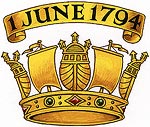
The Queen's have had a long and close association with the Royal Navy. In 1794 detachments of the Queen's were embarked on Admiral Lord Howe's flagship the Queen Charlotte and the Royal George, Defence, Majestic and Russell. In Army Order No 132 published in 1909, King George V, in recognition of services as Marines on board vessels of the British Fleet, graciously permitted the Queen's to bear upon their Colours a Naval Crown superscribed '1st June 1794'.
The links formed between the Royal Navy and the Regiment have endured and been passed on to successor Regiments to this day. The traditions of Lord Howe' s flagship were inherited by HMS Excellent, which for many years was the Naval Gunnery School at Portsmouth. They still use the march 'Braganza' .
At a Dinner held at Whale Island on the 30th May 1924, on the occasion of the Annual Cricket Match between The Queen's Royal Regiment and HMS Excellent the Regiment was asked if they would kindly consent to the Regimental March being adopted as the March of HMS Excellent.
This proposal was agreed to pending the final approval of the Colonel of the Regiment General Sir Charles Carmichael Monro, Bart, GCB, GCSI, GCMG, and a wire was dispatched to him asking for his consent. General Monro was at that time Governor of Gibraltar. General Monro agreed to the proposal. A ceremony was arranged for the handing over of the March to HMS Excellent and took place on the 24th July 1924 at Whale Island. The ceremony was carried out as follows:-
The Band of Drums of the Regiment were drawn up facing the Band of HMS Excellent. The Regimental Band played the March whilst countermarching through the ranks of the HMS Excellent Band. The two bands then played the March together conducted by Mr J Buckle, Bandmaster of the Regiment. Mr Buckle then handed over to the Bandmaster of HMS Excellent a silver cylinder containing a parchment on which the Authority of General Sir C C Monro for HMS Excellent to use the March was inscribed.
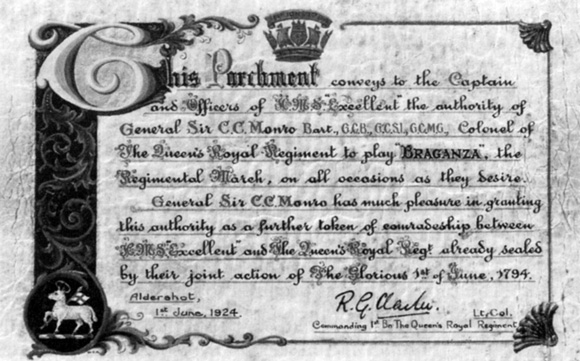
The parchment Authority granted to HMS Excellent, which is on show in the wardroom on the Mess Presidents desk. This parchment conveys to the Captain and Officers of HMS Excellent the authority of General Sir CC Monro Bart GCB GCSI GCMG, Colonel of The Queen's Royal Regiment to play Braganza, The Regimental March, on all occasions as they desire. General Sir CC Monro Bart has much pleasure in granting this authority as a further token of comradeship between HMS Excellent and The Queen's Royal Regt already sealed by their joint action of The Glorious First of June 1794.
After the ceremony the combined Bands and Drums Beat Retreat. The occasion happened to coincide with the Royal Review at Spithead and was witnessed by a large number of distinguished naval officers who had assembled at Portsmouth for the Review. After the ceremony, the Gunnery Officers' entertained officers of the Regiment to dinner in the Wardroom of HMS Excellent. A number of officers and their wives went round the Fleet in a pinnace placed at their disposal by the officers of HMS Excellent.
Authority was also given to Whitgift School, Charterhouse School and the Royal Grammar School at Guildford for their cadet units to use the march.
'We'll Gang Nae Mair to Yon Toun'
,The Regimental Quick March of The 2nd Battalion The Queen's Royal Regiment.

We'll Gang Nae Mair to Yon Toun
A Colonel Bruce raised the Battalion in 1857. He had previously served in the Highland Light Infantry, and he introduced this Scottish tune as a march-past. From 1883 the tune was used as a march-past by both Battalions and after the adoption of 'Braganza' it remained as a secondary Regimental Quickstep. Some unofficial words were:
O The Queen's they do like duff, they do like duff
but they never get enough, (repeated)
'I'll gang nae mair to yon toun' a Scottish air by an unknown author with words, it is claimed, taken from a Bums ballad:
I'll gang nae mair to yon toun,
O never a' my life again;
I'll never gae back to yon toun,
To seek anither wife again.
Corps of Drums 6th Service Bn The Queen's (Royal West Surrey) Regiment
at Aldershot in 1915, just prior to embarkation for France
.(Click to enlarge)
Slow Marches
'March from Scipio'
The Regimental Slow March of The Queen's Royal Regiment. This stately tune comes from Handel's opera 'Scipio' which was first performed in London in 1726.
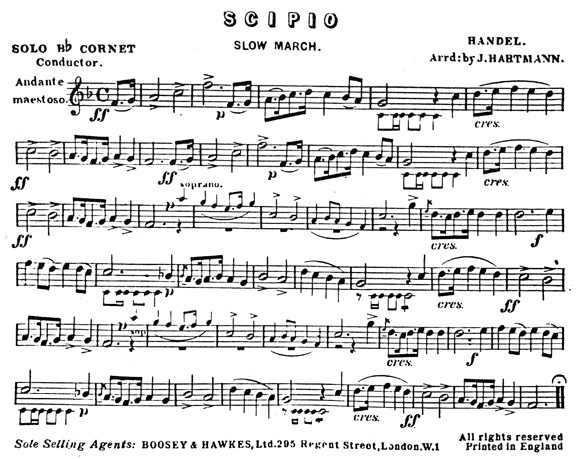
March from Scipio
Tradition relates, however, that the composer wrote this as a parade march long before it occurred to him to bolster up the somewhat tenuous score of his opera with its stirring strains.
'Bonnie Dundee' Many years ago 'Bonnie Dundee' was incorporated m the ceremonial parade music of The Queen's Royal Regiment. This tune is perhaps best associated with the musical drive of the RHA. Today this tune is perpetuated on three main occasions, Royal Salute in Hyde Park, part of the Musical Drive, and in the Officers' Mess at Woolwich.

Bonnie Dundee
In 1958 when the list of recommended marches for the amalgamated music of The Queen's Royal Surrey Regiment was submitted to Major General J Y Whitfield the last Colonel of the Queen's, 'Bonnie Dundee' was omitted. The General enquired why and the answer was given that it was thought highly unlikely that the Adjutant would ever gallop on parade to collect 'Reports' again. General Whitfield disagreed and insisted on the tune being included. At Bury St Edmunds on the first internal parade of the 1st Bn The Queen's Royal Surrey Regiment, the Adjutant, Captain Mike Pereira, ordered the band to play 'Bonnie Dundee', pedalled on parade mounted on a very ancient bicycle GS, and solemnly collected reports from companies.
Whether General Whitfield had any say in the matter of marches for the Presentation of Colours Parade on 22nd April 1960 is not known, but the march was used twice on that parade, and to the writers knowledge it has never been used since.
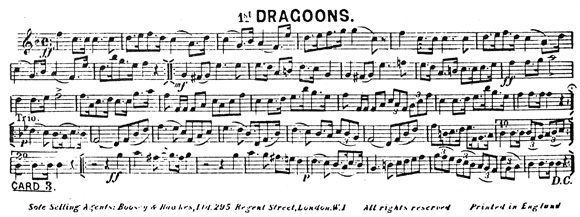
The Royal Dragoons Slow March
'The Royal Dragoons Slow March'. The Regimental Slow March of the Royal Dragoons. It was at one time in use by The Queen's Royal Regiment, played in commemoration of the Regiment's early days in Tangier. At the time, a troop of horse renowned for its dash -later to become the Royal Dragoons -was attached to the Regiment.
'Tangier's March'. In 1985, during research into another subject, Lieutenant General J P Riley, CB, DSO, PhD, MA came across various references in Seventeenth Century documents to a march played by the Tangier Garrison between 1670 and 1684. Part of the music is quoted by Nathaniel Thompson (1) and some of its many verses, which relate to the political mismanagement of the colony, are quoted by Routh (2). After the return of the garrison and the later collapse of the Army in the face of the Dutch invasion of 1688, the March vanished and seems to have been superseded during the Jacobite War in Ireland by 'Lilliburlero'. This is not surprising, given its favourable references to James II when Duke of York.
Further research into the March with the assistance of Mr James Meikle, music librarian of the Royal Military School of Music, revealed that in 1968, an old manuscript of the music had come to light in the archives of the Royal Dragoons, formerly the Tangier Horse. This had presumably survived as the Royals had the privilege of always serving at Home in peacetime. The then Band Master of the Royals, Douglas Mackay, arranged the March and it was recorded on a long playing record of the Regimental music which is now a rare item. On the amalgamation of the Royals with the Royal Horse Guards in 1969 the Royal Dragoons' music library was sold to the 4th/7th Royal Dragoon Guards but in the process, the manuscript of 'Tangier's March' was lost once more.
It has now, however been possible from Thompson's original and a surviving copy of the record, to reconstruct the march with all its original words. It is a slow march, since seventeenth century marching pace was considerably slower than that of modem times. It would originally have been scored only for fifes and drums. The march is of comparable antiquity with the oldest military music in the Army, such as 'Dumbarton's Drums', and 'When the King Enjoys His Own Again'.
1) Nathanial Thompson - A Choice Collection of 180 Loyal Songs (London 1685)
2) EMG Routh Tangier 1661-1684: England's Lost Atlantic Outpost, (London 1912)
The Drums of the 1st Bn The Queen's Royal West Surrey Regiment, taken at Picqigny, Somme, 1917
Top: F. Hill, Jackson
Back Row: Forrest, Cochrane*, W. H. Parsons, G. Fane, Hall, Allen, Shergold, Portbury
Middle Row: Griffin, Evans, Dyer, A.N.O.. Willis, Crust, Williams, Donovan, A.N.O.., A.N.O.. Pelham, Cruickshank
Bottom Row: Duveiger, C. Hill, D Maj J. Winter•, Lt Col Crofts, Lt Nevins•, RSM Read, Wilson•, Andrews
Believed to have been the last man killed in the 1st Battalion, Killed in Action 11 Nov 18.
•Embarked for France with 1st Queen's in August 1914 and served with the Battalion throughout.
(Click to enlarge)
Drummer, The Queen's (Royal West Surrey) Regiment c 1908
(Click to enlarge)
Related
